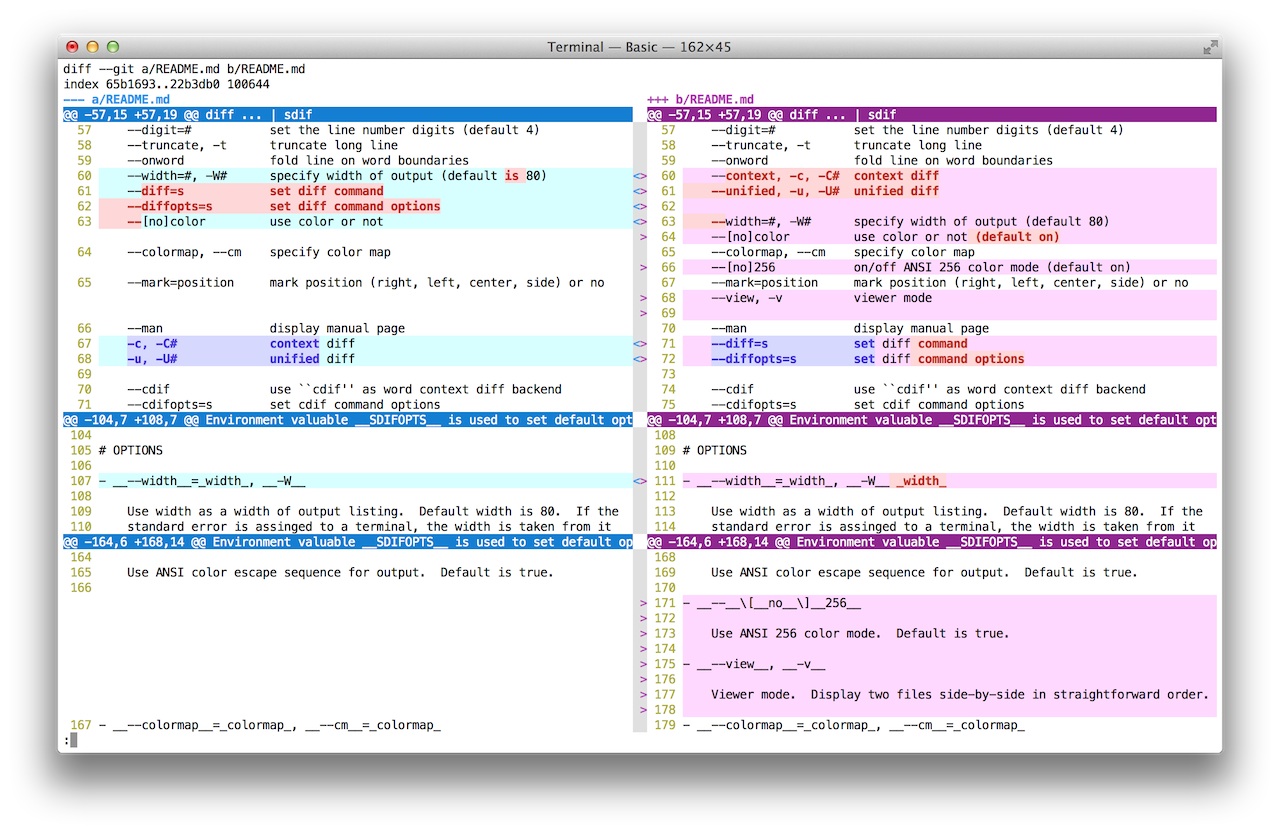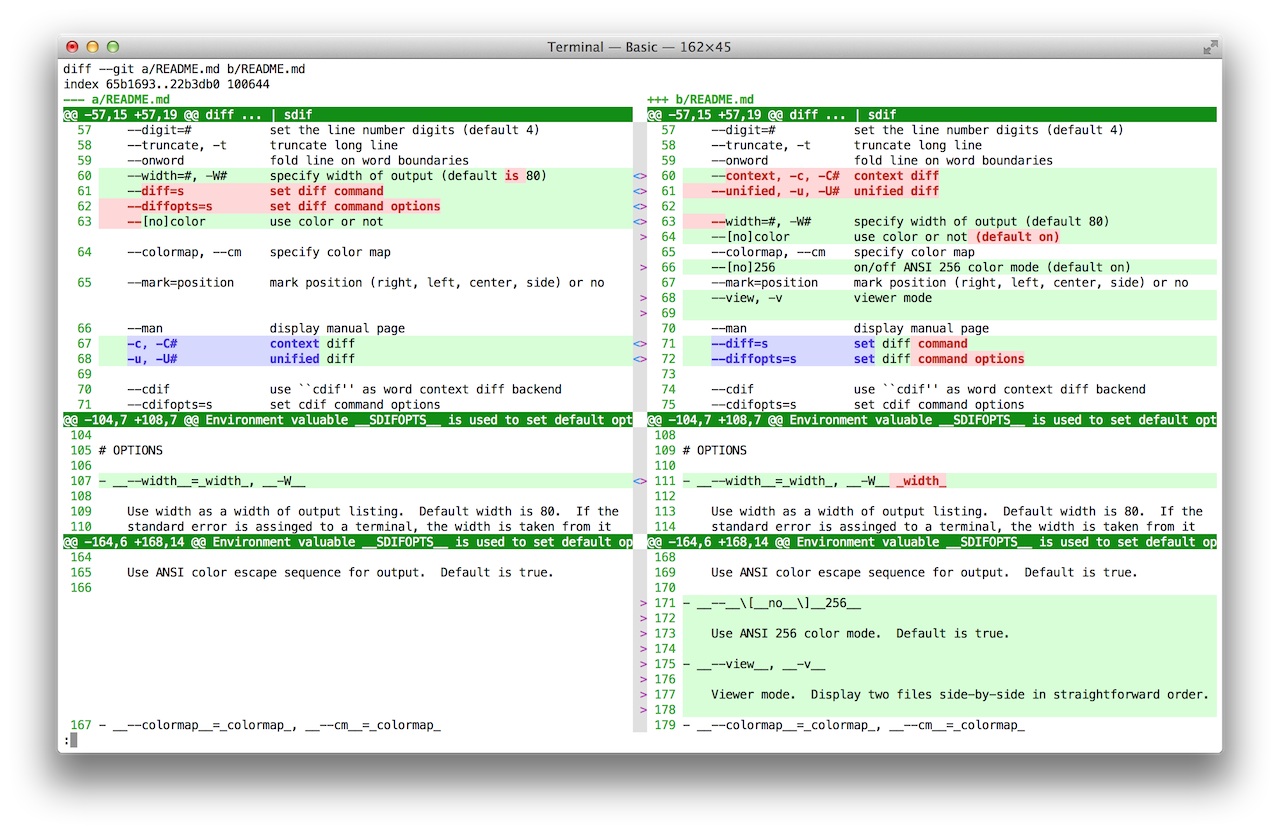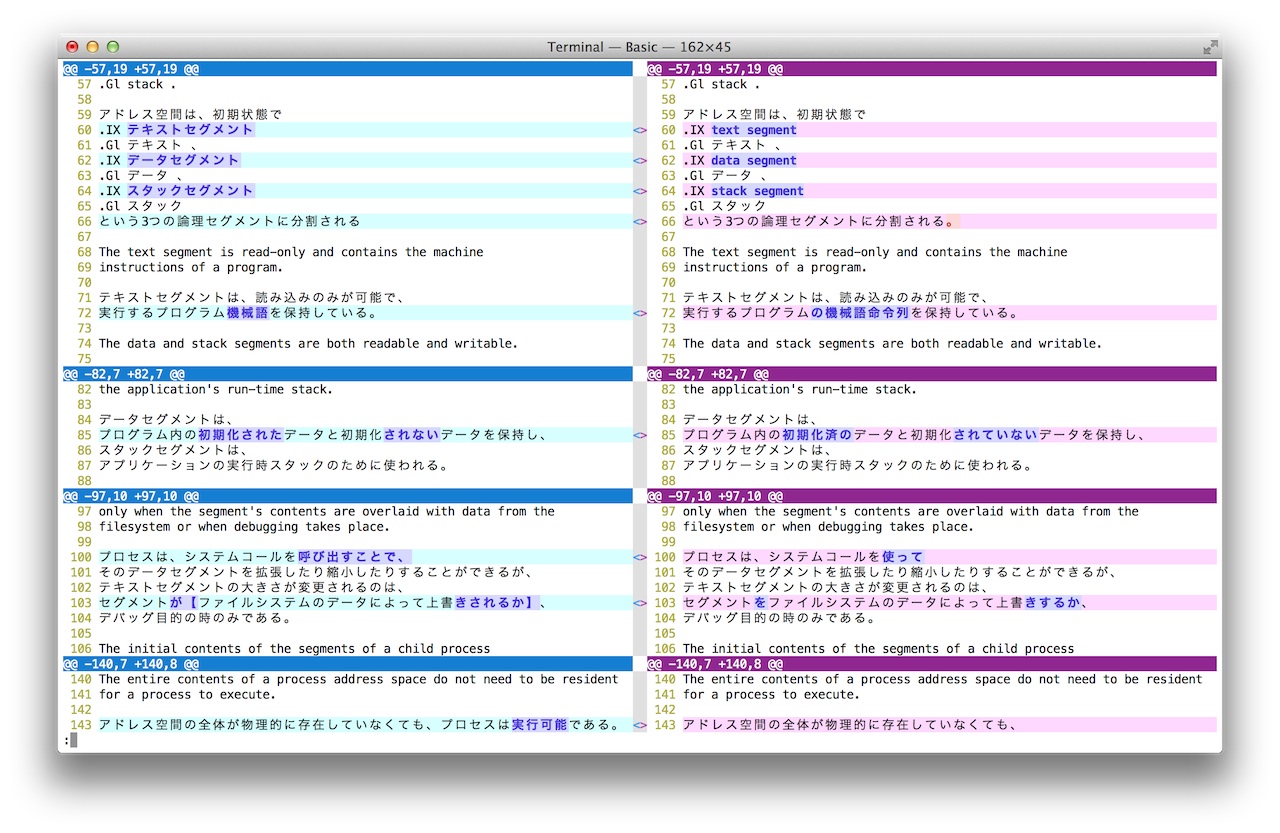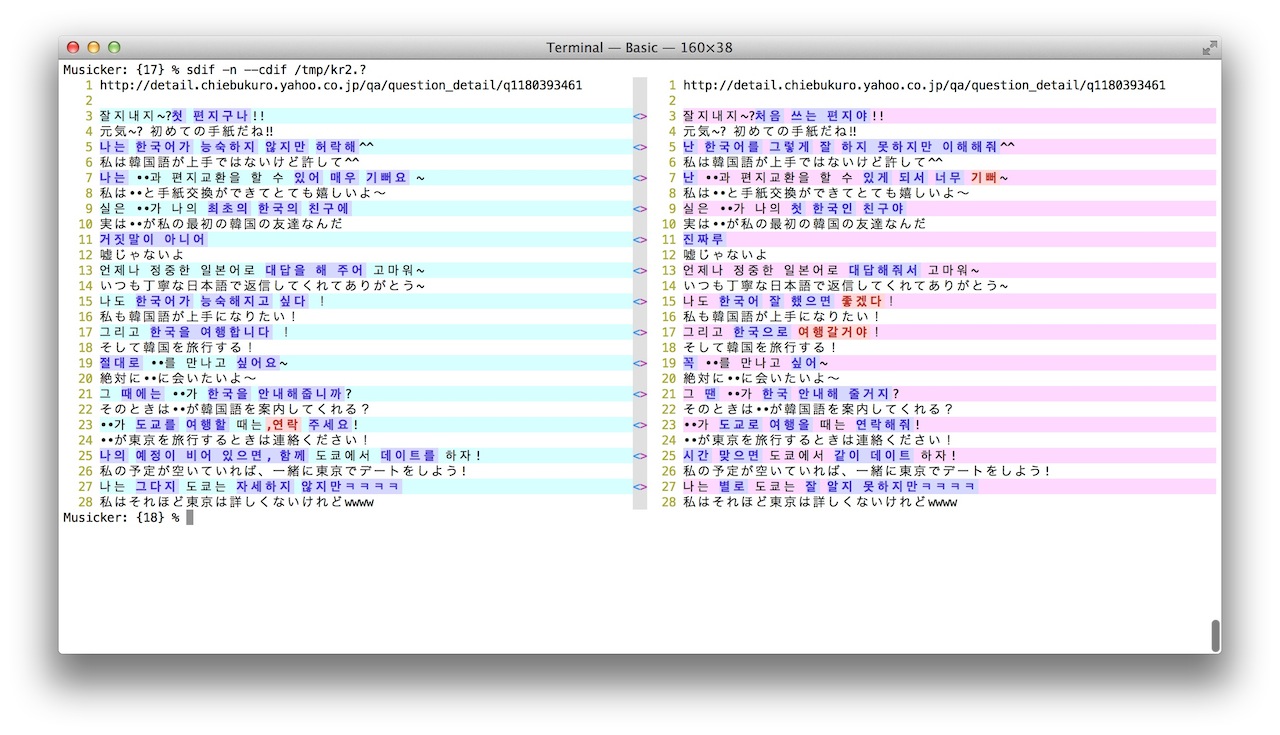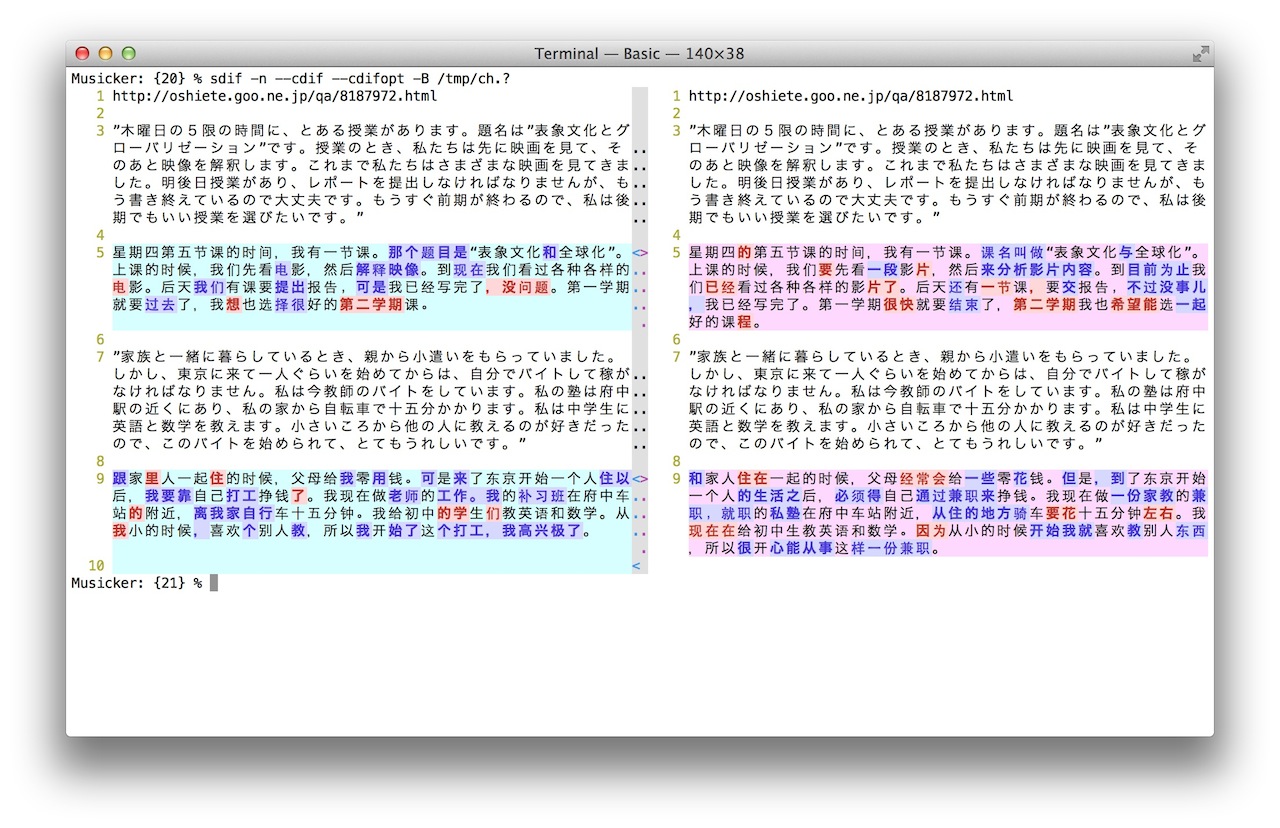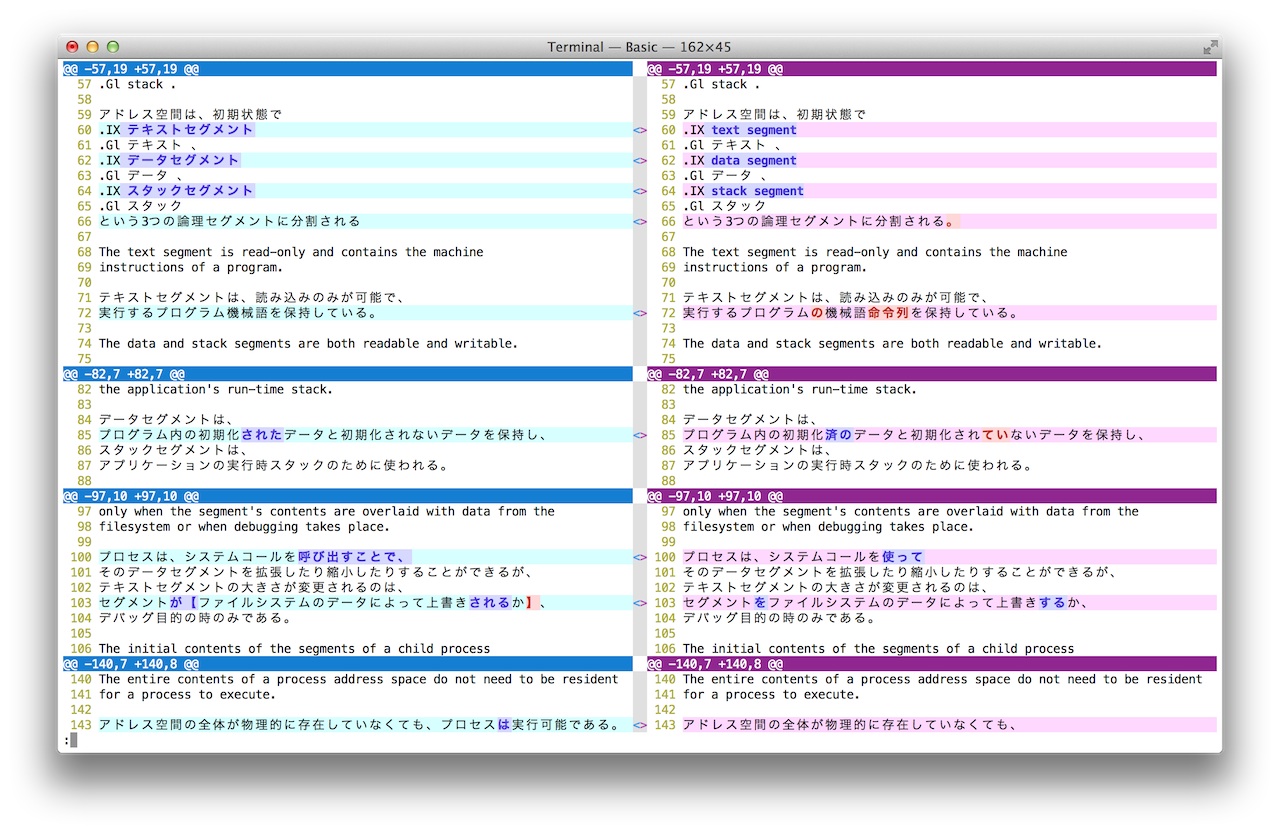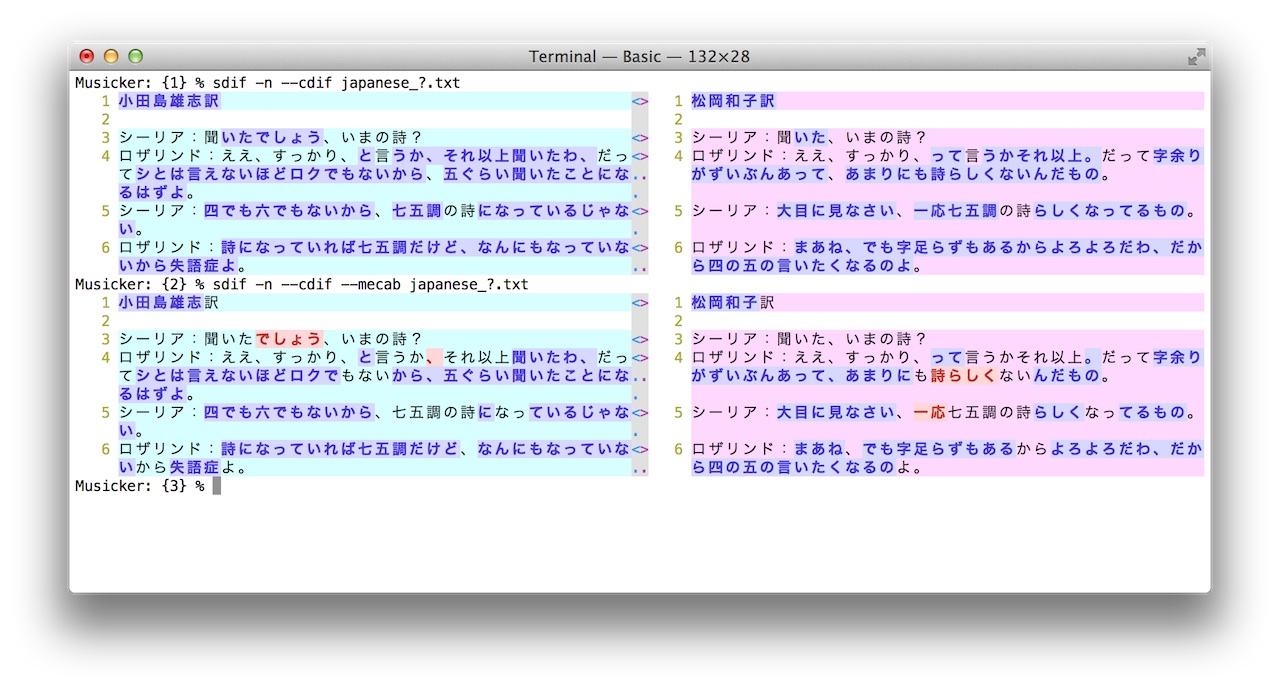Sdif
sdif - side-by-side diff viewer for ANSI terminal
This project is maintained by kaz-utashiro
SDIF
is Side-by-side diff viewer
for ANSI color terminal
capable of word context display powerd by CDIF
Flexible color
ANSI 256 colors
International
Unicode
East Asian wide width character
Japanese Kanji/Hiragana/Katakana separation
Korean
Chinese
Japanese syllable tokenizer
–mecab morphology
NAME
sdif - side-by-side diff viewer for ANSI terminal
SYNOPSIS
sdif file_1 file_2
| diff … | sdif |
--number, -n print line number
--digit=# set the line number digits (default 4)
--truncate, -t truncate long line
--onword fold line on word boundaries
--context, -c, -C# context diff
--unified, -u, -U# unified diff
--width=#, -W# specify width of output (default 80)
--[no]color use color or not (default on)
--colormap, --cm specify color map
--colortable show color table
--[no]256 on/off ANSI 256 color mode (default on)
--mark=position mark position (right, left, center, side) or no
--view, -v viewer mode
--man display manual page
--diff=s set diff command
--diffopts=s set diff command options
--cdif use ``cdif'' as word context diff backend
--cdifopts=s set cdif command options
--mecab pass --mecab option to cdif
DESCRIPTION
sdif is inspired by System V sdiff(1) command. The basic feature of sdif is making a side-by-side listing of two different files. All contents of two files are listed on left and right sides. Center column is used to indicate how different those lines. No mark means no difference. Added, deleted and modified lines are marked with `-‘ and `+’ character.
1 deleted -
2 same 1 same
3 changed -+ 2 modified
4 same 3 same
+ 4 added
It also reads and formats the output from diff command from standard input. Besides normal diff output, context diff -c and unified diff -u output will be handled properly. Combined diff format is also supported, but currently limited up to three files.
Each lines can be displayed in different colors. Read –colormap section in this manual for detail.
While sdif doesn’t care about the contents of each modified lines, it can read the output from cdif command which show the word context differences of each lines. Option –cdif set the appropriate options for cdif. Set –nocc, –nomc options at least when invoking cdif manually. Option –notc is preferable because text color can be handled by sdif.
Environment valuable SDIFOPTS is used to set default options.
OPTIONS
-
–width=width, -W width
Use width as a width of output listing. Default width is 80. If the standard error is assigned to a terminal, the width is taken from it if possible.
-
–number, -n
Print line number on each lines.
-
–digit=n
Line number is displayed in 4 digits by default. Use this option to change it.
-
-c, -Cn, -u, -Un
Passed through to the back-end diff command. Sdif can interpret the output from normal, context (diff -c) and unified diff (diff -u).
-
–truncate, -t
Truncate lines if they are longer than printing width.
-
–onword
Fold long line at word boundaries.
-
–cdif
Use cdif command instead of normal diff command.
-
–cdifopts=option
Specify options for back-end cdif command.
-
–mecab
Pass –mecab option to back-end cdif command. Use –cdifopts to set other options.
-
–diff=command
Any command can be specified as a diff command to be used. Piping output to sdif is easier unless you want to get whole text.
-
–diffopts=option
Specify options for back-end diff command.
-
–mark=position
Specify the position for a mark. Choose from left, right, center, side or no. Default is center.
-
–[no]color
Use ANSI color escape sequence for output. Default is true.
-
–[no]256
Use ANSI 256 color mode. Default is true.
-
–colortable
Show table of ANSI 216 colors.
-
–view, -v
Viewer mode. Display two files side-by-side in straightforward order.
-
–colormap=colormap, –cm=colormap
Basic colormap format is :
FIELD=COLORwhere the FIELD is one from these :
OLD NEW MERGED UNCHANGED --------- --------- --------- --------- OCOMMAND NCOMMAND MCOMMAND : Command line OFILE NFILE MFILE : File name OMARK NMARK MMARK UMARK : Mark OLINE NLINE MLINE ULINE : Line number OTEXT NTEXT MTEXT UTEXT : TextIf UMARK and/or ULINE is empty, OMARK/NMARK and/or OLINE/NLINE are used instead.
You can make multiple fields same color joining them by = :
FIELD1=FIELD2=...=COLORAlso wildcard can be used for field name :
*CHANGE=BDwMultiple fields can be specified by repeating options
--cm FILED1=COLOR1 --cm FIELD2=COLOR2 ...or combined with comma (,) :
--cm FILED1=COLOR1,FIELD2=COLOR2, ...COLOR is a combination of single character representing uppercase foreground color :
R Red G Green B Blue C Cyan M Magenta Y Yellow K Black W Whiteand alternative (usually brighter) colors in lowercase :
r, g, b, c, m, y, k, wor RGB values and 24 grey levels if using ANSI 256 or full color terminal :
FORMAT: foreground[/background] COLOR: 000 .. 555 : 6 x 6 x 6 216 colors 000000 .. FFFFFF : 24bit RGB mapped to 216 colors L00 .. L23 : 24 grey levels Sample: 005 0000FF : blue foreground /505 /FF00FF : magenta background 000/555 000000/FFFFFF : black on white 500/050 FF0000/00FF00 : red on greenand other effects :
S Stand-out (reverse video) U Underline D Double-struck (boldface) F Flash (blink) E ExpandE is effective for command, file and text line. That line will be expanded to window width filling up by space characters. Left column is expanded always. You may want to use this to set background color for right column.
Defaults are :
OCOMMAND => "555/010E" or "GSE" NCOMMAND => "555/010E" or "GSE" MCOMMAND => "555/010E" or "GSE" OFILE => "555/010DE" or "GSDE" NFILE => "555/010DE" or "GSDE" MFILE => "555/010DE" or "GSDE" OMARK => "010/444" or "G/W" NMARK => "010/444" or "G/W" MMARK => "010/444" or "G/W" UMARK => "" OLINE => "220" or "Y" NLINE => "220" or "Y" MLINE => "220" or "Y" ULINE => "" OTEXT => "KE/454" or "G" NTEXT => "KE/454" or "G" MTEXT => "KE/454" or "G" UTEXT => ""This is equivalent to :
sdif --cm '?COMMAND=555/010E,?FILE=555/010DE' \ --cm '?MARK=010/444,UMARK=' \ --cm '?LINE=220,ULINE=' \ --cm '?TEXT=KE/454,UTEXT='
AUTHOR
- Kazumasa Utashiro
- https://github.com/kaz-utashiro/
